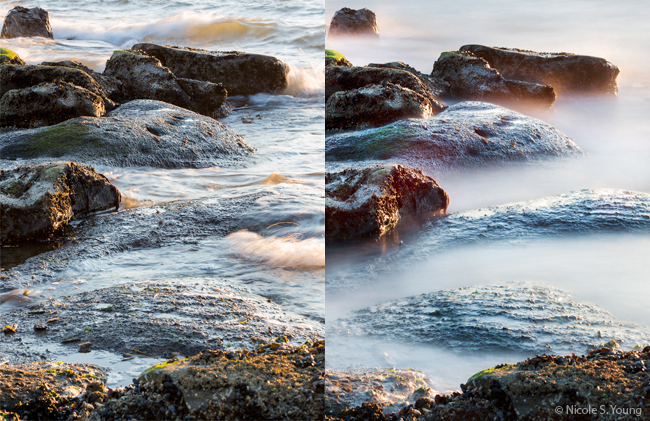

5 Tips for Long Exposure Photography
By Amy Wright | Jan 17, 2018
If you’ve ever wanted to create photographs with smooth, silky water, star trails, or even wind-streaked cloudy skies then you’re probably a fan of long exposure photography. Long exposures can add surrealism and serenity to an otherwise crisp and harsh photograph and looks great as a framed or canvas print.
Here are some tips on how to create your own long exposure photographs.
Composition is key
When creating a long exposure photograph, especially with water, it’s important to realize that the water will ultimately turn into a soft, misty white fog and the surrounding area (such as rocks or shoreline) will remain as the main elements of the image. So when composing your image make sure you “ignore” the waves and just focus in on the rocks, branches, or whatever else you have in your scene. Look for triangulation of the elements, curves, and also keep in mind photographic principles such as the rule of thirds. It can sometimes be easy to forget this as you’re watching the crashing waves create shapes over and around the rest of the landscape, but once you start creating your exposures you can adjust and zone-in on the other elements.
Find a scene with movement
Long exposure photography is not just limited to waterfalls, rocky shorelines and night skies with star trails. A street corner filled with people in the middle of the day, a windy day with a sky filled with puffy clouds and a curvy road lit up with cars and street-lights all make wonderful subjects as well. The key is to find a good backdrop, frame it with a beautiful composition and then fill the rest in with movement. Most of the time it’s a lot of experimentation and trial-and-error, which (in my honest opinion) is what makes creating long exposure photographs so darn fun.
Steady your camera with a tripod
Aside from your camera, a tripod is the most critical piece of equipment needed in order to create a successful long exposure image. A sturdy, solid, three-legged tripod is definitely going to help, but any way to immobilize your camera will do, such as with a mini tripod or even a good sand-bag.
Expose in Bulb mode with a cable release
The unfortunate thing about cameras is that they have a maximum internal shutter speed length of 30 seconds. So in order to create a longer exposure and extend the shutter speed beyond 30 seconds you’ll need to get used to having your camera set to the Bulb mode. When using Bulb mode you choose the aperture, and then the shutter stays open for as long as you have the shutter button pressed down, which is also why using a cable release is so important. A cable release is a device that connects to your camera and acts as the shutter button and allows you to keep the shutter open as long as you need to make a proper exposure. There are several different kinds of cable releases, all with varying price points, but you really don’t need anything fancy to get the job done.
Use neutral density (ND) filters for longer exposures
When photographing during the day, one problem you’re likely to run into is that there’s just too much light to get a long enough exposure to blur the water, clouds … or whatever it is you want to photograph. You can always try stopping down your aperture to a smaller setting (like ƒ/22), but if the sun is too bright then you may be out of luck … unless, of course, you have neutral density (ND) filters. An ND filter is a piece of dark glass that reduces the amount light coming in through your lens. This, in turn, allows you to have longer shutter speeds and create long exposures, even in broad daylight (depending on the intensity of the ND filter). ND filters are categorized in terms of “stops”, and the more “stops” your filter has the darker it is, and the longer your exposure will be. You can get circular filters that screw on to the front of your lens, or (my favorite) square and rectangle filters that sit in front of the glass using a filter holder. Note: If you don’t have any ND filters the good thing is that you can still create beautiful long exposure images without them. Try and find shady spots to photograph water, or wait until the sun gets low in the sky and the light starts to fade.
Nicole S. Young is a full-time photographer and author currently living in Seattle, Washington. She specializes in food and stock photography and licenses her images through iStockphoto and Getty Images. You can find Nicole on her blog and Twitter.
Our friend, photographer Nicole S. Young, is a member of the CanvasPop Pro Community. She’s a full-time photographer based in Seattle, who’s also an author, poet and dreamer. We love her work!
Photo above: Canon 5DMkIII, Canon 70-200mm f/4L IS lens, ISO 100 Left image: 1/8 sec at f/16 Right image: 2 min 9 sec at f/16 (with Lee 10-stop ND filter)